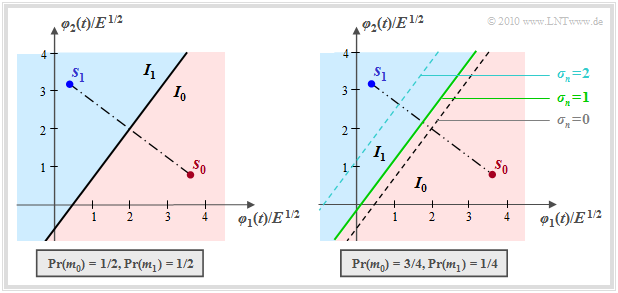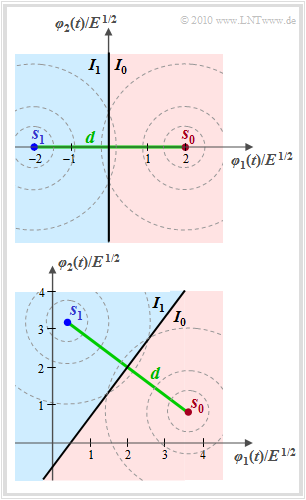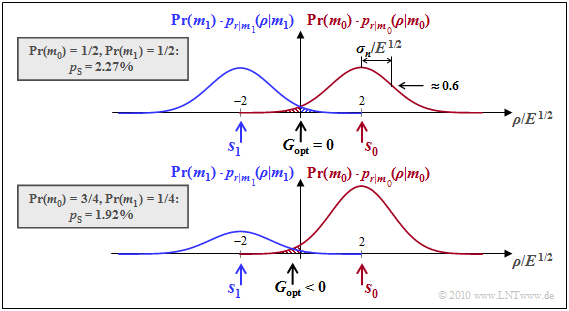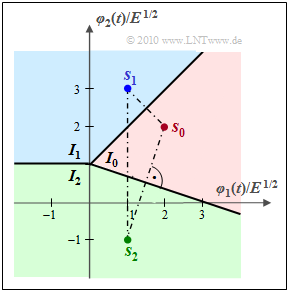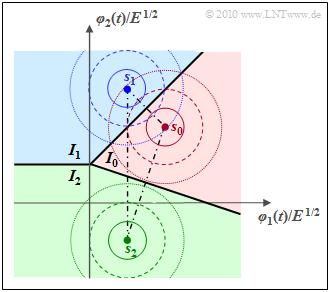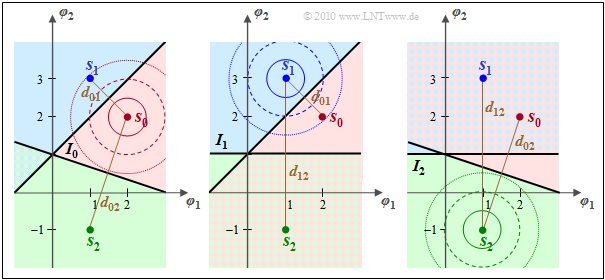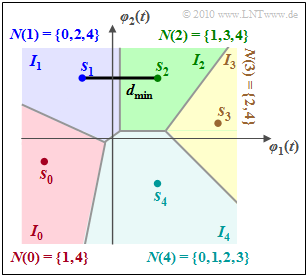Contents
- 1 Optimal decision with binary transmission
- 2 The special case of equally probable binary symbols
- 3 Error probability for symbols with equal probability
- 4 Optimal threshold for non-equally probable symbols
- 5 Entscheidungsregionen im nichtbinären Fall
- 6 Fehlerwahrscheinlichkeitsberechnung im nichtbinären Fall
- 7 Union Bound - Obere Schranke für die Fehlerwahrscheinlichkeit
- 8 Weitere Aufwandsreduzierung bei der Union Bound
- 9 Aufgaben zum Kapitel
Optimal decision with binary transmission
We assume here a transmission system which can be characterized as follows: $\boldsymbol{r} = \boldsymbol{s} + \boldsymbol{n}$. This system has the following properties:
- The vector space fully describing the transmission system is spanned by $N = 2$ mutually orthogonal basis functions $\varphi_1(t)$ and $\varphi_2(t)$.
- Consequently, the probability density function of the additive and white Gaussian noise is also to be set two-dimensional, characterized by the vector $\boldsymbol{ n} = (n_1,\hspace{0.05cm}n_2)$.
- There are only two possible transmitted signals $(M = 2)$, described by the two vectors $\boldsymbol{ s_0} = (s_{01},\hspace{0.05cm}s_{02})$ and $\boldsymbol{ s_1} = (s_{11},\hspace{0.05cm}s_{12})$:
- $$s_0(t)= s_{01} \cdot \varphi_1(t) + s_{02} \cdot \varphi_2(t) \hspace{0.05cm},\hspace{1cm}s_1(t) = s_{11} \cdot \varphi_1(t) + s_{12} \cdot \varphi_2(t) \hspace{0.05cm}.$$
- The two messages $m_0 \ \Leftrightarrow \ \boldsymbol{ s_0}$ and $m_1 \ \Leftrightarrow \ \boldsymbol{ s_1}$ are not necessarily equally probable.
- The task of the decision is to give an estimate for the current reception vector $\boldsymbol{r}$ according to the "MAP decision rule". In the present case, this rule is:
- $$\hat{m} = {\rm arg} \max_i \hspace{0.1cm} \big[ {\rm Pr}( m_i) \cdot p_{\boldsymbol{ r} \hspace{0.05cm}|\hspace{0.05cm}m } (\boldsymbol{ \rho } \hspace{0.05cm}|\hspace{0.05cm} m_i )\big ] \hspace{0.15cm} \in \hspace{0.15cm}\{ m_i\}\hspace{0.3cm}{\rm with}\hspace{0.3cm} \boldsymbol{ r } = \boldsymbol{ \rho } = (\rho_1, \hspace{0.05cm}\rho_2) \hspace{0.05cm}.$$
In the special case $N = 2$ and $M = 2$ considered here, the decision partitions the two-dimensional space into the two disjoint areas $I_0$ (highlighted in red) and $I_1$ (blue), as the following graphic illustrates. If the received value lies in $I_0$, $m_0$ is output as the estimated value, otherwise $m_1$.
$\text{Derivation and picture description:}$ For the AWGN channel and $M = 2$, the decision rule is thus:
Always choose message $m_0$ if the following condition is satisfied:
- $${\rm Pr}( m_0) \cdot {\rm exp} \left [ - \frac{1}{2 \sigma_n^2} \cdot \vert \hspace{-0.05cm} \vert \boldsymbol{ \rho } - \boldsymbol{ s }_0 \vert \hspace{-0.05cm} \vert^2 \right ] > {\rm Pr}( m_1) \cdot {\rm exp} \left [ - \frac{1}{2 \sigma_n^2} \cdot\vert \hspace{-0.05cm} \vert \boldsymbol{ \rho } - \boldsymbol{ s }_1 \vert \hspace{-0.05cm} \vert^2 \right ] \hspace{0.05cm}.$$
The boundary line between the two decision regions $I_0$ and $I_1$ is obtained by replacing the greater than sign with the equal sign in the above equation and transforming the equation slightly:
- $$\vert \hspace{-0.05cm} \vert \boldsymbol{ \rho } - \boldsymbol{ s }_0 \vert \hspace{-0.05cm} \vert^2 - 2 \sigma_n^2 \cdot {\rm ln} \hspace{0.15cm}\big [{\rm Pr}( m_0)\big ] = \vert \hspace{-0.05cm} \vert \boldsymbol{ \rho } - \boldsymbol{ s }_1 \vert \hspace{-0.05cm} \vert^2 - 2 \sigma_n^2 \cdot {\rm ln} \hspace{0.15cm}\big [{\rm Pr}( m_1)\big ]$$
- $$\Rightarrow \hspace{0.3cm} \vert \hspace{-0.05cm} \vert \boldsymbol{ s }_1 \vert \hspace{-0.05cm} \vert^2 - \vert \hspace{-0.05cm} \vert \boldsymbol{ s }_0 \vert \hspace{-0.05cm} \vert^2 + 2 \sigma_n^2 \cdot {\rm ln} \hspace{0.15cm} \frac{ {\rm Pr}( m_0)}{ {\rm Pr}( m_1)} = 2 \cdot \boldsymbol{ \rho }^{\rm T} \cdot (\boldsymbol{ s }_1 - \boldsymbol{ s }_0)\hspace{0.05cm}.$$
From this plot one can see:
- The boundary curve between regions $I_0$ and $I_1$ is a straight line, since the equation of determination is linear in the received vector $\boldsymbol{ \rho } = (\rho_1, \hspace{0.05cm}\rho_2)$.
- For equally probable symbols, the boundary is exactly halfway between $\boldsymbol{ s }_0$ and $\boldsymbol{ s }_1$ and rotated by $90^\circ$ with respect to the line connecting the transmitting points (left graph):
- $$\vert \hspace{-0.05cm} \vert \boldsymbol{ s }_1 \vert \hspace{-0.05cm} \vert ^2 - \vert \hspace{-0.05cm} \vert \boldsymbol{ s }_0 \vert \hspace{-0.05cm} \vert ^2 = 2 \cdot \boldsymbol{ \rho }^{\rm T} \cdot (\boldsymbol{ s }_1 - \boldsymbol{ s }_0)\hspace{0.05cm}.$$
- For ${\rm Pr}(m_0) > {\rm Pr}(m_1)$, the decision boundary is shifted toward the less likely symbol $\boldsymbol{ s }_1$, and the more so the larger the AWGN standard deviation $\sigma_n$.
- The green-dashed decision boundary in the right figure as well as the decision regions $I_0$ (red) and $I_1$ (blue) are valid for the (normalized) standard deviation $\sigma_n = 1$ and the dashed boundary lines for $\sigma_n = 0$ and $\sigma_n = 2$, respectively.
The special case of equally probable binary symbols
We continue to assume a binary system $(M = 2)$, but now consider the simple case where this can be described by a single basis function $(N = 1)$. The error probability for this has already been calculated in the section "Definition of the Bit Error Probability".
With the nomenclature and representation form chosen for the fourth main chapter the following constellation results:
- The received value $r = s + n$ is now a scalar and is composed of the transmitted signal $s \in \{s_0, \hspace{0.05cm}s_1\}$ and the noise term $n$ additively. The abscissa $\rho$ denotes a realization of $r$.
- In addition, the abscissa is normalized to the reference quantity $\sqrt{E}$, whereas here the normalization energy $E$ has no prominent, physically interpretable meaning.
- The noise term $n$ is Gaussian distributed with mean $m_n = 0$ and variance $\sigma_n^2$. The root of the variance $(\sigma_n)$ is called the rms value or the standard deviation.
- The decision boundary $G$ divides the entire value range of $r$ into the two subranges $I_0$ $($in which, among other things, $s_0$ lies$)$ and $I_1$ $($with the signal value $s_1)$.
- If $\rho > G$, the decision returns the estimated value $m_0$, otherwise $m_1$. Here it is assumed that the message $m_i$ is uniquely related to the transmitted signal $s_i$: $m_i \Leftrightarrow s_i$.
The graph shows the conditional (one-dimensional) probability density functions $p_{\hspace{0.02cm}r\hspace{0.05cm} \vert \hspace{0.05cm}m_0}$ and $p_{\hspace{0.02cm}r\hspace{0.05cm} \vert \hspace{0.05cm}m_1}$ for the AWGN channel, assuming equal symbol probabilities: ${\rm Pr}(m_0) = {\rm Pr}(m_1) = 0.5$. Thus, the (optimal) decision boundary is $G = 0$. One can see from this plot:
- If $m = m_0$ and thus $s = s_0 = 2 \cdot E^{1/2}$, an erroneous decision occurs only if $\eta$, the realization of the noise quantity $n$, is smaller than $-2 \cdot E^{1/2}$. In this case, $\rho < 0$, where $\rho$ denotes a realization of the received value $r$.
- In contrast, for $m = m_1$ ⇒ $s = s_1 = -2 \cdot E^{1/2}$, an erroneous decision occurs whenever $\eta$ is greater than $+2 \cdot E^{1/2}$. In this case, $\rho > 0$.
Error probability for symbols with equal probability
Let ${\rm Pr}(m_0) = {\rm Pr}(m_1) = 0.5$. For AWGN noise with rms (standard deviation) $\sigma_n$, as already calculated in the section "Definition of the bit error probability" with different nomenclature, we obtain for the probability of a wrong decision $(\cal E)$ under the condition that message $m_0$ was sent:
- $${\rm Pr}({ \cal E}\hspace{0.05cm} \vert \hspace{0.05cm} m_0) = \int_{-\infty}^{G = 0} p_{r \hspace{0.05cm}|\hspace{0.05cm}m_0 } ({ \rho } \hspace{0.05cm} \vert \hspace{0.05cm}m_0 ) \,{\rm d} \rho = \int_{-\infty}^{- s_0 } p_{{ n} \hspace{0.05cm}\vert\hspace{0.05cm}m_0 } ({ \eta } \hspace{0.05cm}|\hspace{0.05cm}m_0 ) \,{\rm d} \eta = \int_{-\infty}^{- s_0 } p_{{ n} } ({ \eta } ) \,{\rm d} \eta = \int_{ s_0 }^{\infty} p_{{ n} } ({ \eta } ) \,{\rm d} \eta = {\rm Q} \left ( {s_0 }/{\sigma_n} \right ) \hspace{0.05cm}.$$
In deriving the equation, it was considered that the AWGN noise $\eta$ is independent of the signal $(m_0$ or $m_1)$ and has a symmetric PDF. The complementary Gaussian error integral was also used
- $${\rm Q}(x) = \frac{1}{\sqrt{2\pi}} \int_{x}^{\infty} {\rm e}^{-u^2/2} \,{\rm d} u \hspace{0.05cm}.$$
Correspondingly, for $m = m_1$ ⇒ $s = s_1 = -2 \cdot E^{1/2}$:
- $${\rm Pr}({ \cal E} \hspace{0.05cm}\vert\hspace{0.05cm} m_1) = \int_{0}^{\infty} p_{{ r} \hspace{0.05cm}\vert\hspace{0.05cm}m_1 } ({ \rho } \hspace{0.05cm}\vert\hspace{0.05cm}m_1 ) \,{\rm d} \rho = \int_{- s_1 }^{\infty} p_{{ n} } (\boldsymbol{ \eta } ) \,{\rm d} \eta = {\rm Q} \left ( {- s_1 }/{\sigma_n} \right ) \hspace{0.05cm}.$$
$\text{Conclusion:}$ With the distance $d = s_1 - s_0$ of the signal space points, we can summarize the results, still considering ${\rm Pr}(m_0) + {\rm Pr}(m_1) = 1$:
- $${\rm Pr}({ \cal E}\hspace{0.05cm}\vert\hspace{0.05cm} m_0) = {\rm Pr}({ \cal E} \hspace{0.05cm}\vert\hspace{0.05cm} m_1) = {\rm Q} \big ( {d}/(2{\sigma_n}) \big )$$
- $$\Rightarrow \hspace{0.3cm}{\rm Pr}({ \cal E} ) = {\rm Pr}(m_0) \cdot {\rm Pr}({ \cal E} \hspace{0.05cm}\vert\hspace{0.05cm} m_0) + {\rm Pr}(m_1) \cdot {\rm Pr}({ \cal E} \hspace{0.05cm}\vert\hspace{0.05cm} m_1)= \big [ {\rm Pr}(m_0) + {\rm Pr}(m_1) \big ] \cdot {\rm Q} \big [ {d}/(2{\sigma_n}) \big ] = {\rm Q} \big [ {d}/(2{\sigma_n}) \big ] \hspace{0.05cm}.$$
Notes:
- This equation is valid under the condition $G = 0$ quite generally, thus also for ${\rm Pr}(m_0) \ne {\rm Pr}(m_1)$.
- For "non-equally probable symbols", however, the error probability can be reduced by a different decision threshold.
- The equation mentioned here is also valid if the signal space points are not scalars but are described by the vectors $\boldsymbol{ s}_0$ and $\boldsymbol{ s}_1$.
- The distance $d$ results then as the norm of the difference vector: $d = \vert \hspace{-0.05cm} \vert \hspace{0.05cm} \boldsymbol{ s}_1 - \boldsymbol{ s}_0 \hspace{0.05cm} \vert \hspace{-0.05cm} \vert \hspace{0.05cm}.$
$\text{Example 1:}$ Let's look again at the signal space constellation from the "first chapter page" (lower graphic) with the values
- $\boldsymbol{ s}_0/E^{1/2} = (3.6, \hspace{0.05cm}0.8)$ and
- $\boldsymbol{ s}_1/E^{1/2} = (0.4, \hspace{0.05cm}3.2)$.
Here the distance of the signal space points is
- $$d = \vert \hspace{-0.05cm} \vert s_1 - s_0 \vert \hspace{-0.05cm} \vert = \sqrt{E \cdot (0.4 - 3.6)^2 + E \cdot (3.2 - 0.8)^2} = 4 \cdot \sqrt {E}\hspace{0.05cm}.$$
This results in exactly the same value as for the upper constellation with
- $\boldsymbol{ s}_0/E^{1/2} = (2, \hspace{0.05cm}0)$ and
- $\boldsymbol{ s}_1/E^{1/2} = (-2, \hspace{0.05cm}0)$.
The figures show these two constellations and reveal the following similarities and differences, respectively, assuming AWGN noise variance $\sigma_n^2 = N_0/2$ in each case. The circles in the graph illustrate the circular symmetry of 2D AWGN noise.
- As said before, both the distance of the signal points from the decision line $(d/2 = 2 \cdot \sqrt {E})$ and the AWGN characteristic value $\sigma_n$ are the same in both cases.
- It follows: The two arrangements lead to the same error probability if the parameter $E$ (a kind of normalization energy) is kept constant:
- $${\rm Pr} ({\rm Symbolfehler}) = {\rm Pr}({ \cal E} ) = {\rm Q} \big [ {d}/(2{\sigma_n}) \big ]\hspace{0.05cm}.$$
- The mean energy per symbol $(E_{\rm S})$ for the upper constellation is given by
- $$E_{\rm S} = 1/2 \cdot \vert \hspace{-0.05cm} \vert s_0 \vert \hspace{-0.05cm} \vert^2 + 1/2 \cdot \vert \hspace{-0.05cm} \vert s_1 \vert \hspace{-0.05cm} \vert^2 = E/2 \cdot \big[(+2)^2 + (-2)^2\big] = 4 \cdot {E}\hspace{0.05cm}.$$
- With the lower constellation one receives in the same way:
- $$E_{\rm S} = \ \text{...} \ = E/2 \cdot \big[(3.6)^2 + (0.8)^2\big] + E/2 \cdot \big[(0.4)^2 + (3.2)^2 \big] = 12 \cdot {E}\hspace{0.05cm}.$$
- For a given mean energy per symbol $(E_{\rm S})$, the upper constellation is therefore clearly superior to the lower one: The same error probability results with one third of the energy per symbol. This issue will be discussed in detail in "Exercise 4.6Z".
Optimal threshold for non-equally probable symbols
If ${\rm Pr}(m_0) \ne {\rm Pr}(m_1)$ holds, a slightly smaller error probability can be obtained by shifting the decision boundary $G$. The following results are derived in detail in the sample solution to "Exercise 4.7":
- For unequal symbol probabilities, the optimal decision boundary $G_{\rm opt}$ between regions $I_0$ and $I_1$ is closer to the less likely symbol.
- The normalized optimal shift with respect to the limit $G = 0$ for equally probable symbols is
- \[\gamma_{\rm opt} = \frac{G_{\rm opt}}{s_0 } = 2 \cdot \frac{ \sigma_n^2}{d^2} \cdot {\rm ln} \hspace{0.15cm} \frac{{\rm Pr}( m_1)}{{\rm Pr}( m_0)} \hspace{0.05cm}.\]
- The error probability is then equal to
- $${\rm Pr}({ \cal E} ) = {\rm Pr}(m_0) \cdot {\rm Q} \big[ {d}/(2{\sigma_n}) \cdot (1 - \gamma_{\rm opt}) \big ] + {\rm Pr}(m_1) \cdot {\rm Q} \big [ {d}/(2{\sigma_n}) \cdot (1 + \gamma_{\rm opt}) \big ]\hspace{0.05cm}.$$
$\text{Example 2:}$ The formal parameter $\rho$ (abscissa) again denotes a realization of the AWGN random variable $r = s + n$.
For the following is further valid:
- $$\boldsymbol{ s }_0 = (2 \cdot \sqrt{E}, \hspace{0.1cm} 0), \hspace{0.2cm} \boldsymbol{ s }_1 = (- 2 \cdot \sqrt{E}, \hspace{0.1cm} 0)$$
- $$ \Rightarrow \hspace{0.2cm} d = 2 \cdot \sqrt{E}, \hspace{0.2cm} \sigma_n = \sqrt{E} \hspace{0.05cm}.$$
- For equally probable symbols ⇒ ${\rm Pr}( m_0) = {\rm Pr}( m_1) = 1/2$, the optimal decision boundary is $G_{\rm opt} = 0$ (see upper sketch). This gives us for the error probability:
- $${\rm Pr}({ \cal E} ) = {\rm Q} \big [ {d}/(2{\sigma_n}) \big ] = {\rm Q} (2) \approx 2.26\% \hspace{0.05cm}.$$
- Now we consider unequal symbol probabilities with ${\rm Pr}( m_0) = 3/4\hspace{0.05cm},\hspace{0.1cm}{\rm Pr}( m_1) = 1/4\hspace{0.05cm}$ (lower sketch). Let the other system variables be unchanged from the upper graph. In this case the optimal (normalized) shift factor is
- \[\gamma = 2 \cdot \frac{ \sigma_n^2}{d^2} \cdot {\rm ln} \hspace{0.15cm} \frac{ {\rm Pr}( m_1)}{ {\rm Pr}( m_0)} = 2 \cdot \frac{ E}{16 \cdot E} \cdot {\rm ln} \hspace{0.15cm} \frac{1/4}{3/4 } \approx - 0.14 \hspace{0.05cm},\]
- which is a $14\%$ shift toward the less likely symbol $\boldsymbol {s}_1$ (i.e., to the left). This makes the error probability slightly smaller than for equally likely symbols:
- \[{\rm Pr}({ \cal E} )= 0.75 \cdot {\rm Q} \left ( 2 \cdot 1.14 \right ) + 0.25 \cdot {\rm Q} \left ( 2 \cdot 0.86 \right ) = 0.75 \cdot 0.0113 + 0.25 \cdot 0.0427 \approx 1.92\% \hspace{0.05cm}.\]
One recognizes from these numerical values:
- Due to the threshold shift, the symbol $\boldsymbol {s}_1$ is now more distorted, but the more probable symbol $\boldsymbol {s}_0$ is distorted disproportionately less.
- Das Ergebnis sollte aber nicht zu Fehlinterpretationen führen. Im unsymmetrischen Fall ⇒ ${\rm Pr}( m_0) \ne {\rm Pr}( m_1)$ ergibt sich zwar eine kleinere Fehlerwahrscheinlichkeit als für ${\rm Pr}( m_0) ={\rm Pr}( m_1) = 0.5$, aber mit jedem Symbol kann dann auch nur weniger Information übertragen werden.
- Bei den gewählten Zahlenwerten $0.81 \ \rm bit/Symbol$ statt $1\ \rm bit/Symbol$. Aus informationstheoretischer Sicht wäre ${\rm Pr}( m_0) ={\rm Pr}( m_1)$ optimal.
$\text{Fazit:}$
- Im symmetrischen Fall ⇒ ${\rm Pr}( m_0) ={\rm Pr}( m_1)$ können zur Entscheidungsfindung die herkömmlichen bedingten WDF–Werte $p_{r \hspace{0.05cm}\vert \hspace{0.05cm}m } ( \rho \hspace{0.05cm}\vert \hspace{0.05cm}m_i )$ herangezogen werden.
- Im unsymmetrischen Fall ⇒ ${\rm Pr}( m_0) \ne {\rm Pr}( m_1)$ müssen diese Funktionen vorher gewichtet werden: ${\rm Pr}(m_i) \cdot p_{r \hspace{0.05cm}\vert \hspace{0.05cm}m_i } ( \rho \hspace{0.05cm}\vert \hspace{0.05cm}m_i )$.
Im Folgenden wird dieser Sachverhalt berücksichtigt.
Entscheidungsregionen im nichtbinären Fall
Allgemein partitionieren die Entscheidungsregionen $I_i$ den $N$–dimensionalen reellen Raum in $M$ zueinander disjunkte Gebiete. $I_i$ ist dabei definiert als die Menge aller Punkte, die zum Schätzwert $m_i$ führen:
- \[\boldsymbol{ \rho } \in I_i \hspace{0.2cm} \Longleftrightarrow \hspace{0.2cm} \hat{m} = m_i, \hspace{0.3cm}{\rm wobei}\hspace{0.3cm}I_i = \left \{ \boldsymbol{ \rho } \in { \cal R}^N \hspace{0.05cm} | \hspace{0.05cm} {\rm Pr}( m_i) \cdot p_{\boldsymbol{ r} \hspace{0.05cm}|\hspace{0.05cm}m } (\boldsymbol{ \rho } \hspace{0.05cm} | \hspace{0.05cm} m_i ) > {\rm Pr}( m_k) \cdot p_{\boldsymbol{ r} \hspace{0.05cm}|\hspace{0.05cm}m } (\boldsymbol{ \rho } \hspace{0.05cm} | \hspace{0.05cm}m_k )\hspace{0.15cm} \forall k \ne i \right \} \hspace{0.05cm}.\]
- Die Form der Entscheidungsregionen $I_i$ mit $i = 0$, ... , $M-1$ im $N$–dimensionalen Raum hängen von den bedingten Wahrscheinlichkeitsdichtefunktionen $p_{r \hspace{0.05cm}\vert \hspace{0.05cm}m }$ ab, also vom betrachteten Kanal.
- In vielen Fällen – so auch beim AWGN–Kanal – sind die Entscheidungsgrenzen zwischen je zwei Signalpunkten Gerade, was die weiteren Betrachtungen vereinfacht.
$\text{Beispiel 3:}$ Die Grafik zeigt die Entscheidungsregionen $I_0$, $I_1$ und $I_2$ für ein Übertragungssystem mit den Parametern $N = 2$ und $M = 3$. Die normierten Sendevektoren sind dabei
- \[\boldsymbol{ s }_0 = (2,\hspace{0.05cm} 2), \hspace{0.2cm} \hspace{0.01cm} \boldsymbol{ s }_1 = (1,\hspace{0.05cm} 3), \hspace{0.01cm} \hspace{0.2cm} \boldsymbol{ s }_2 = (1,\hspace{0.05cm} -1) \hspace{0.05cm}.\]
Es sind nun zwei Fälle zu unterscheiden:
- Bei gleichwahrscheinlichen Symbolen ⇒ ${\rm Pr}( m_0) = {\rm Pr}( m_1) ={\rm Pr}( m_2) = 1/3 $ verlaufen die Grenzen zwischen jeweils zwei Regionen stets geradlinig, mittig und rechtwinklig zu den Verbindungsgeraden.
- Bei ungleichen Symbolwahrscheinlichkeiten sind dagegen die Entscheidungsgrenzen jeweils in Richtung des unwahrscheinlicheren Symbols (parallel) zu verschieben – umso weiter, je größer die AWGN–Streuung $\sigma_n$ ist.
Fehlerwahrscheinlichkeitsberechnung im nichtbinären Fall
Nachdem die Entscheidungsregionen $I_i$ festliegen, kann man die Symbolfehlerwahrscheinlichkeit des Gesamtsystems berechnen. Wir benutzen folgende Bezeichnungen, wobei wir aufgrund der Einschränkungen durch unseren Zeichensatz im Fließtext manchmal andere Namen als in Gleichungen verwenden müssen:
- Symbolfehlerwahrscheinlichkeit: ${\rm Pr}({ \cal E} ) = {\rm Pr(Symbolfehler)} \hspace{0.05cm},$
- Wahrscheinlichkeit für eine korrekte Entscheidung: ${\rm Pr}({ \cal C} ) = 1 - {\rm Pr}({ \cal E} ) = {\rm Pr(korrekte \hspace{0.15cm} Entscheidung)} \hspace{0.05cm},$
- Bedingte Wahrscheinlichkeit einer korrekten Entscheidung unter der Bedingung $m = m_i$: ${\rm Pr}({ \cal C}\hspace{0.05cm}|\hspace{0.05cm} m_i ) = 1 - {\rm Pr}({ \cal E} \hspace{0.05cm}|\hspace{0.05cm} m_i) \hspace{0.05cm}.$
Mit diesen Definitionen gilt für die Wahrscheinlichkeit einer korrekten Entscheidung:
- \[{\rm Pr}({ \cal C} ) \hspace{-0.1cm} = \hspace{-0.1cm} \sum\limits_{i = 0}^{M-1} {\rm Pr}(m_i) \cdot {\rm Pr}({ \cal C}\hspace{0.05cm}|\hspace{0.05cm} m_i ) = \sum\limits_{i = 0}^{M-1} {\rm Pr}(m_i) \cdot {\rm Pr}(\boldsymbol{ r } \in I_i\hspace{0.05cm}|\hspace{0.05cm} m_i ) = \sum_{i = 0}^{M-1} {\rm Pr}(m_i) \cdot \int_{I_i} p_{{ \boldsymbol{ r }} \hspace{0.05cm}|\hspace{0.05cm}m } (\boldsymbol {\rho } \hspace{0.05cm}|\hspace{0.05cm} m_i ) \,{\rm d} \boldsymbol {\rho } \hspace{0.05cm}.\]
Für den AWGN–Kanal gilt dabei entsprechend dem Abschnitt $N$–dimensionales Gaußsches Rauschen:
- \[{\rm Pr}({ \cal C}\hspace{0.05cm}|\hspace{0.05cm} m_i ) = 1 - {\rm Pr}({ \cal E} \hspace{0.05cm}|\hspace{0.05cm} m_i) = \frac{1}{(\sqrt{2\pi} \cdot \sigma_n)^N} \cdot \int_{I_i} {\rm exp} \left [ - \frac{1}{2 \sigma_n^2} \cdot || \boldsymbol{ \rho } - \boldsymbol{ s }_i ||^2 \right ] \,{\rm d} \boldsymbol {\rho }\hspace{0.05cm}.\]
- Dieses Integral muss im allgemeinen Fall numerisch berechnet werden.
- Nur bei einigen wenigen, einfach beschreibbaren Entscheidungsregionen $\{I_i\}$ ist eine analytische Lösung möglich.
$\text{Beispiel 4:}$ Beim AWGN–Kanal liegt eine 2D–Gaußglocke um den Sendepunkt $\boldsymbol{ s }_i$, in der linken Grafik erkennbar an den konzentrischen Höhenlinien.
- Etwas willkürlich ist zudem die Entscheidungsgerade $G$ eingezeichnet.
- Rechts dargestellt ist in einem anderen Koordinatensystem (verschoben und gedreht) allein die WDF der Rauschkomponente.
Die Grafik kann wie folgt interpretiert werden:
- Die Wahrscheinlichkeit, dass der Empfangsvektor nicht in das "Sollgebiet" $I_i$ fällt, sondern in das rot hinterlegte Gebiet $I_k$, ist $ {\rm Q} (A/\sigma_n)$.
- $A$ bezeichnet den Abstand zwischen $\boldsymbol{ s }_i$ und $G$.
- $\sigma_n$ gibt den Effektivwert (Wurzel aus der Varianz) des AWGN–Rauschens an und ${\rm Q}(x)$ ist die Gaußsche Fehlerfunktion.
- Entsprechend ist die Wahrscheinlichkeit für das Ereignis $r \in I_i$ gleich dem Komplementärwert
- \[{\rm Pr}({ \cal C}\hspace{0.05cm}\vert\hspace{0.05cm} m_i ) = {\rm Pr}(\boldsymbol{ r } \in I_i\hspace{0.05cm} \vert \hspace{0.05cm} m_i ) = 1 - {\rm Q} (A/\sigma_n)\hspace{0.05cm}.\]
Wir betrachten nun die oben angegebenen Gleichungen
- \[{\rm Pr}({ \cal C} ) = \sum\limits_{i = 0}^{M-1} {\rm Pr}(m_i) \cdot {\rm Pr}({ \cal C}\hspace{0.05cm}|\hspace{0.05cm} m_i ) \hspace{0.3cm}{\rm mit} \hspace{0.3cm} {\rm Pr}({ \cal C}\hspace{0.05cm}|\hspace{0.05cm} m_i ) = \int_{I_i} p_{{ \boldsymbol{ r }} \hspace{0.05cm}|\hspace{0.05cm}m } (\boldsymbol {\rho } \hspace{0.05cm}|\hspace{0.05cm} m_i ) \,{\rm d} \boldsymbol {\rho } \hspace{0.05cm}\]
etwas genauer, wobei wir wieder von zwei Basisfunktionen $(N = 2)$ und den drei Signalraumpunkten $\boldsymbol{ s }_0$, $\boldsymbol{ s }_1$ und $\boldsymbol{ s }_2$ $(M = 3)$ ausgehen.
- Die Entscheidungsregionen $I_0$, $I_1$ und $I_2$ sind bestmöglich gewählt.
- Das AWGN–Rauschen ist in der Skizze durch jeweils drei kreisförmige Höhenlinien angedeutet.
Man erkennt aus dieser Darstellung:
- Unter der Voraussetzung, dass $m = m_i \ \Leftrightarrow \ \boldsymbol{ s } = \boldsymbol{ s }_i$ gesendet wurde, wird nur dann eine richtige Entscheidung getroffen, wenn der Empfangswert $\boldsymbol{ r }$ in der Region $I_i$ liegt.
- Die Wahrscheinlichkeit ${\rm Pr}(\boldsymbol{ r } \in I_i\hspace{0.05cm}|\hspace{0.05cm}m_2)$ ist für $i = 2$ (weitaus) am größten ⇒ richtige Entscheidung. ${\rm Pr}(\boldsymbol{ r } \in I_0\hspace{0.05cm}|\hspace{0.05cm}m_2)$ ist deutlich kleiner. Nahezu vernachlässigbar ist ${\rm Pr}(\boldsymbol{ r } \in I_1\hspace{0.05cm}|\hspace{0.05cm}m_2)$.
- Die Verfälschungswahrscheinlichkeiten für $m = m_0$ bzw. $m = m_1$ lauten somit:
- \[{\rm Pr}({ \cal E}\hspace{0.05cm}|\hspace{0.05cm} m_0 )={\rm Pr}(\boldsymbol{ r } \in I_1\hspace{0.05cm}|\hspace{0.05cm} m_0 ) + {\rm Pr}(\boldsymbol{ r } \in I_2\hspace{0.05cm}|\hspace{0.05cm} m_0 ),\]
- \[ {\rm Pr}({ \cal E}\hspace{0.05cm}|\hspace{0.05cm} m_1 ) ={\rm Pr}(\boldsymbol{ r } \in I_0\hspace{0.05cm}|\hspace{0.05cm} m_1 ) + {\rm Pr}(\boldsymbol{ r } \in I_2\hspace{0.05cm}|\hspace{0.05cm} m_1 ) \hspace{0.05cm}.\]
- Die größte Verfälschungswahrscheinlichkeit ergibt sich für $m = m_0$. Wegen
- \[{\rm Pr}(\boldsymbol{ r } \in I_1\hspace{0.05cm}|\hspace{0.05cm} m_0 ) \approx {\rm Pr}(\boldsymbol{ r } \in I_0\hspace{0.05cm}|\hspace{0.05cm} m_1 ) \hspace{0.05cm}, \]
- \[{\rm Pr}(\boldsymbol{ r } \in I_2\hspace{0.05cm}|\hspace{0.05cm} m_0 ) \gg {\rm Pr}(\boldsymbol{ r } \in I_2\hspace{0.05cm}|\hspace{0.05cm} m_1 ) \hspace{0.05cm}\]
- gelten folgende Relationen: ${\rm Pr}({ \cal E}\hspace{0.05cm}|\hspace{0.05cm} m_0 ) > {\rm Pr}({ \cal E}\hspace{0.05cm}|\hspace{0.05cm} m_1 ) >{\rm Pr}({ \cal E}\hspace{0.05cm}|\hspace{0.05cm} m_2 )\hspace{0.05cm}. $
$\text{Fazit:}$ Diese Ergebnisse können wie folgt zusammengefasst werden:
- Zur Berechnung der (mittleren) Fehlerwahrscheinlichkeit muss auch bei gleichwahrscheinlichen Symbolen allgemein über alle $M$ Terme gemittelt werden.
- Im Fall gleichwahrscheinlicher Symbole kann ${\rm Pr}(m_i) = 1/M$ vor die Summation gezogen werden, was allerdings den Rechengang nicht sonderlich vereinfacht.
- Nur bei symmetrischer Anordnung kann auf die Mittelung verzichtet werden.
Union Bound - Obere Schranke für die Fehlerwahrscheinlichkeit
Bei beliebigen Werten von $M$ gilt für die Verfälschungswahrscheinlichkeit unter der Voraussetzung, dass die Nachricht $m_i$ $($bzw. das Signal $\boldsymbol{s}_i)$ gesendet wurde:
- \[{\rm Pr}({ \cal E}\hspace{0.05cm}|\hspace{0.05cm} m_i ) = {\rm Pr} \left [ \bigcup_{k \ne i} { \cal E}_{ik}\right ] \hspace{0.05cm},\hspace{0.5cm}{ \cal E}_{ik}\hspace{-0.1cm}: \boldsymbol{ r }{\rm \hspace{0.15cm}liegt \hspace{0.15cm}n\ddot{a}her \hspace{0.15cm}bei \hspace{0.15cm}}\boldsymbol{ s }_k {\rm \hspace{0.15cm}als \hspace{0.15cm}beim \hspace{0.15cm}Sollwert \hspace{0.15cm}}\boldsymbol{ s }_i \hspace{0.05cm}. \]
$\text{Definition:}$ Für diesen Ausdruck lässt sich mit einer Booleschen Ungleichung – der so genannten Union Bound – eine obere Schranke angeben:
- \[{\rm Pr}({ \cal E}\hspace{0.05cm}\vert\hspace{0.05cm} m_i ) \le \sum\limits_{k = 0, \hspace{0.1cm}k \ne i}^{M-1} {\rm Pr}({ \cal E}_{ik}) = \sum\limits_{k = 0, \hspace{0.1cm}k \ne i}^{M-1}{\rm Q} \big [ d_{ik}/(2{\sigma_n}) \big ]\hspace{0.05cm}. \]
Anmerkungen:
- $d_{ik} = \vert \hspace{-0.05cm} \vert \boldsymbol{s}_i - \boldsymbol{s}_k \vert \hspace{-0.05cm} \vert$ ist der Abstand der Signalraumpunkte $\boldsymbol{s}_i$ und $\boldsymbol{s}_k$.
- $\sigma_n$ gibt den Effektivwert des AWGN–Rauschens an.
- Die Union Bound ist nur bei gleichwahrscheinlichen Symbolen ⇒ ${\rm Pr}(m_i) = 1/M$ anwendbar.
- Auch dann muss zur Berechnung der (mittleren) Fehlerwahrscheinlichkeit über alle $m_i$ gemittelt werden.
$\text{Beispiel 5:}$ Die Grafik verdeutlicht die Union Bound am Beispiel $M = 3$ mit gleichwahrscheinlichen Symbolen: ${\rm Pr}(m_0) = {\rm Pr}(m_1) = {\rm Pr}(m_2) =1/3$.
Zu diesen Darstellungen ist anzumerken:
- Für die Symbolfehlerwahrscheinlichkeit gilt:
- \[{\rm Pr}({ \cal E} ) = 1 - {\rm Pr}({ \cal C} ) \hspace{0.05cm},\hspace{0.2cm}{\rm Pr}({ \cal C} ) = {1}/{3} \cdot \big [ {\rm Pr}({ \cal C}\hspace{0.05cm}\vert \hspace{0.05cm} m_0 ) + {\rm Pr}({ \cal C}\hspace{0.05cm}\vert \hspace{0.05cm} m_1 ) + {\rm Pr}({ \cal C}\hspace{0.05cm}\vert \hspace{0.05cm} m_2 ) \big ]\hspace{0.05cm}.\]
- Der erste Term ${\rm Pr}(\boldsymbol{r} \in I_0\hspace{0.05cm}\vert \hspace{0.05cm} m_0)$ im Klammerausdruck unter der Voraussetzung $m = m_0 \ \Leftrightarrow \ \boldsymbol{s} = \boldsymbol{s}_0$ ist in der linken Grafik durch die rote Region $I_0$ visualisiert.
- Die Komplementärregion ${\rm Pr}(\boldsymbol{r} \not\in I_0\hspace{0.05cm}\vert \hspace{0.05cm} m_0)$ ist links entweder blau oder grün oder blau–grün schraffiert markiert. Es gilt ${\rm Pr}({ \cal C}\hspace{0.05cm}\vert\hspace{0.05cm} m_0 ) = 1 - {\rm Pr}({ \cal E}\hspace{0.05cm}\vert \hspace{0.05cm} m_0 )$ mit
- $${\rm Pr}({ \cal E}\hspace{0.05cm}\vert\hspace{0.05cm} m_0 ) = {\rm Pr}(\boldsymbol{ r } \in I_1 \hspace{0.05cm}\cup \hspace{0.05cm} \boldsymbol{ r } \in I_2 \hspace{0.05cm}\vert\hspace{0.05cm} m_0 ) \le {\rm Pr}(\boldsymbol{ r } \in I_1 \hspace{0.05cm}\vert\hspace{0.05cm} m_0 ) + {\rm Pr}(\boldsymbol{ r } \in I_2 \hspace{0.05cm}\vert\hspace{0.05cm} m_0 ) ={\rm Q} \big [ d_{01}/(2{\sigma_n}) \big ]+ {\rm Q} \big [ d_{02}/(2{\sigma_n}) \big ] \hspace{0.05cm}.$$
- Das "$\le$"–Zeichen berücksichtigt hier, dass die blau–grün schraffierte Fläche sowohl zum Gebiet "$\boldsymbol{r} \in I_1$" als auch zum Gebiet "$\boldsymbol{r} \in I_2$" gehört, so dass die Summe einen zu großen Wert liefert. Das heißt: Die Union Bound liefert stets eine obere Schranke.
- Die mittlere Grafik verdeutlicht die Berechnung der Union Bound unter der Voraussetzung, dass $m = m_1 \ \Leftrightarrow \ \boldsymbol{s} = \boldsymbol{s}_1$ gesendet wurde.
- Dem rechten Bild liegt $m = m_2 \ \Leftrightarrow \ \boldsymbol{s} = \boldsymbol{s}_2$ zugrunde.
Weitere Aufwandsreduzierung bei der Union Bound
Die Abschätzung nach der "Union Bound" lässt sich weiter verbessern, indem man nur solche Signalraumpunkte berücksichtigt, die direkte Nachbarn des aktuellen Sendevektors $\boldsymbol{s}_i$ sind:
- \[{\rm Pr}({ \cal E}\hspace{0.05cm}|\hspace{0.05cm} m_i ) = \sum\limits_{k = 0, \hspace{0.1cm} k \ne i}^{M-1}{\rm Q}\big [ d_{ik}/(2{\sigma_n}) \big ] \hspace{0.2cm} \Rightarrow \hspace{0.2cm} {\rm Pr}({ \cal E}\hspace{0.05cm}|\hspace{0.05cm} m_i ) = \sum\limits_{k = 0, \hspace{0.1cm} k \hspace{0.05cm}\in \hspace{0.05cm}N(i)}^{M-1}\hspace{-0.4cm}{\rm Q} \big [ d_{ik}/(2{\sigma_n}) \big ] \hspace{0.05cm}. \]
Dazu definieren wir die Nachbarn von $\boldsymbol{s}_i$ als
- \[N(i) = \left \{ k \in \left \{ i = 0, 1, 2, \hspace{0.05cm}\text{...} \hspace{0.05cm}, M-1 \right \}\hspace{0.05cm}|\hspace{0.05cm} I_i {\rm \hspace{0.15cm}grenzt \hspace{0.15cm}direkt \hspace{0.15cm}an \hspace{0.15cm}}I_k \right \} \hspace{0.05cm}. \]
Die Grafik verdeutlicht diese Definiton am Beispiel $M = 5$. Die Regionen $I_0$ und $I_3$ haben jeweils nur zwei direkte Nachbarn, während $I_4$ an alle anderen Entscheidungsregionen angrenzt.
Durch die Einführung der Nachbarmengen $N(i)$ wird die Qualität der Union Bound–Approximation verbessert, das heißt, die Schranke liegt dann näher an der tatsächlichen Fehlerwahrscheinlichkeit, wird also nach unten verschoben.
Eine weitere und häufig verwendete Schranke benutzt nur den minimalen Abstand $d_{\rm min}$ zwischen zwei Signalraumpunkten. Im obigen Beispiel tritt dieser zwischen $\boldsymbol{s}_1$ und $\boldsymbol{s}_2$ auf. Für gleichwahrscheinliche Symbole ⇒ ${\rm Pr}(m_i) =1/M$ gilt dann die folgende Abschätzung:
- \[{\rm Pr}({ \cal E} ) \le \sum\limits_{i = 0 }^{M-1} \left [ {\rm Pr}(m_i) \cdot \sum\limits_{k \ne i }{\rm Q} \big [d_{ik}/(2{\sigma_n})\big ] \right ] \le \frac{1}{M} \cdot \sum\limits_{i = 0 }^{M-1} \left [ \sum\limits_{k \ne i } {\rm Q} [d_{\rm min}/(2{\sigma_n})] \right ] = \sum\limits_{k \ne i }{\rm Q} \big [d_{\rm min}/(2{\sigma_n})\big ] = (M-1) \cdot {\rm Q} \big [d_{\rm min}/(2{\sigma_n})\big ] \hspace{0.05cm}. \]
Hierzu ist anzumerken:
- Diese Schranke ist auch für große $M$–Werte sehr einfach zu berechnen. Bei vielen Anwendungen ergibt sich jedoch damit für die Fehlerwahrscheinlichkeit ein viel zu großer Wert.
- Die Schranke ist nur dann gleich der tatsächlichen Fehlerwahrscheinlichkeit, wenn alle Regionen an alle anderen direkt angrenzen und die Distanzen aller $M$ Signalpunkte zueinander gleich $d_{\rm min}$ sind.
- Im Sonderfall $M = 2$ sind diese beiden Voraussetzungen häufig erfüllt, so dass die Schranke exakt mit der tatsächlichen Fehlerwahrscheinlichkeit übereinstimmt.
Aufgaben zum Kapitel
Aufgabe 4.6: Optimale Entscheidungsgrenze
Aufgabe 4.6Z: Signalraumkonstellationen
Aufgabe 4.7: Nochmals Entscheidungsgrenzen
Aufgabe 4.8: Entscheidungsregionen bei drei Symbolen
Aufgabe 4.8Z: Fehlerwahrscheinlichkeit bei drei Symbolen
Aufgabe 4.9: Entscheidungsregionen bei Laplace
Aufgabe 4.9Z: Laplace-verteiltes Rauschen
